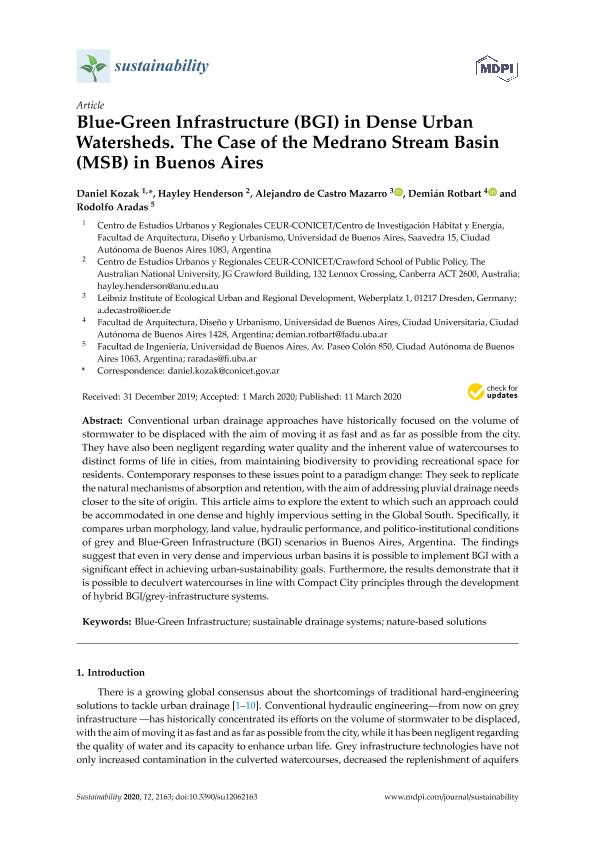Artículo
Blue-green infrastructure (BGI) in dense urban watersheds. The case of the Medrano stream basin (MSB) in Buenos Aires
Kozak, Daniel Matias ; Henderson, Hayley
; Henderson, Hayley ; de Castro Mazarro, Alejandro; Rotbart, Demián; Aradas, Rodolfo
; de Castro Mazarro, Alejandro; Rotbart, Demián; Aradas, Rodolfo
 ; Henderson, Hayley
; Henderson, Hayley ; de Castro Mazarro, Alejandro; Rotbart, Demián; Aradas, Rodolfo
; de Castro Mazarro, Alejandro; Rotbart, Demián; Aradas, Rodolfo
Fecha de publicación:
11/03/2020
Editorial:
Molecular Diversity Preservation International
Revista:
Sustainability
ISSN:
2071-1050
e-ISSN:
2071-1050
Idioma:
Inglés
Tipo de recurso:
Artículo publicado
Clasificación temática:
Resumen
Conventional urban drainage approaches have historically focused on the volume of stormwater to be displaced with the aim of moving it as fast and as far as possible from the city. They have also been negligent regarding water quality and the inherent value of watercourses to distinct forms of life in cities, from maintaining biodiversity to providing recreational space for residents. Contemporary responses to these issues point to a paradigm change: They seek to replicate the natural mechanisms of absorption and retention, with the aim of addressing pluvial drainage needs closer to the site of origin. This article aims to explore the extent to which such an approach could be accommodated in one dense and highly impervious setting in the Global South. Specifically, it compares urban morphology, land value, hydraulic performance, and politico-institutional conditions of grey and Blue-Green Infrastructure (BGI) scenarios in Buenos Aires, Argentina. The findings suggest that even in very dense and impervious urban basins it is possible to implement BGI with a significant effect in achieving urban-sustainability goals. Furthermore, the results demonstrate that it is possible to deculvert watercourses in line with Compact City principles through the development of hybrid BGI/grey-infrastructure systems.
Archivos asociados
Licencia
Identificadores
Colecciones
Articulos(CEUR)
Articulos de CENTRO DE ESTUDIOS URBANOS Y REGIONALES
Articulos de CENTRO DE ESTUDIOS URBANOS Y REGIONALES
Citación
Kozak, Daniel Matias; Henderson, Hayley; de Castro Mazarro, Alejandro; Rotbart, Demián; Aradas, Rodolfo; Blue-green infrastructure (BGI) in dense urban watersheds. The case of the Medrano stream basin (MSB) in Buenos Aires; Molecular Diversity Preservation International; Sustainability; 12; 6; 11-3-2020; 2163
Compartir
Altmétricas



